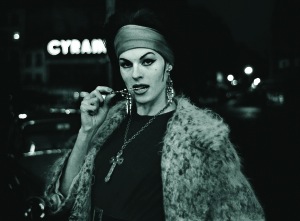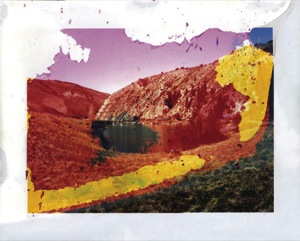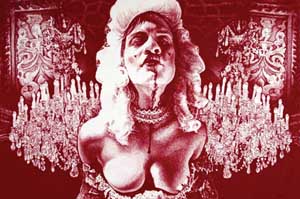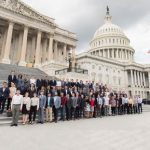
We all love New York, right? Some of us visit for Broadway, the great white way of song and dance and musical theater. Others are drawn to the Statue of Liberty, Central Park and the Empire State Building. Some simply like East Coast anything: time-worn architecture, leafy green trees, hot dogs with mustard and attitude. I love all those things too but I go for the art, wherever it may be. I like being overwhelmed by monumental paintings stored in massive museums like MoMA or the Met and I like discovering odd ideas tucked into any one of the numerous boutique galleries littering Chelsea and the Lower East Side. Most of all I like art that just happens (aka: that thing called life): the people, the rhythm of the city, the sound and the smell of the street.
I spent a week in New York recently, and for the first time I didn’t have a list of urgent things to do. My only agenda was to experience whatever art I stumbled upon as I found it. Not just any art though, gay art in particular. Living in San Diego I get frustrated that there is so little happening that is queer and provocative, that speaks to my community, my experience, my history and my future. It’s not that that I need to live and breathe everything gay. But being gay is my culture and sometimes I would like to be spoken to directly, challenged, entertained and even outraged.
I walked to Chelsea on my first day. The art district seems to have migrated to the broad streets that stop at the old Chelsea Piers. Many spacious galleries can be found in old warehouses beneath the High Line, a wonderfully repurposed above ground train track that is now an inner city walkway full of flower beds. You should see it!
Screw You was an exhibition of “adult-themed” art, publications and other ephemera originating in the era of hippies and beatniks. I made the obligatory circle round the space but I was looking for less X-rated newsprint art and something more fabulous so I left pretty quickly for an exhibition called Summer Camp a short walk away. Summer Camp represented more than 40 years of work about and within ‘camp’ culture and aesthetic – an aesthetic, according to Susan Sontag’s Notes on Camp (1964), focused on artifice, frivolity, naïve middle-class pretentiousness and ‘shocking’ excess. The show included work by familiar names like Tom of Finland and John Waters but also the surprising and unknown, for example a carnal scene that unfolds in Ken Weaver’s obsessively drawn diorama of a busty queen.
Next up was B-Out at the Andre Edlin Gallery. If a busty drag queen threw up her sequins and pearls then this is what B-Out resembled. It was fabulous. The tiny gallery was crammed wall to wall and floor to ceiling with portraits and paintings, sparkle and glitter, humor and darkness by dozens of artists with dozens of aesthetics. Curated by Scott Hug, B-Out proclaimed to “Be outside the box, be outside the system, be out of order and be out of control.” The show certainly was! Can arts “Be out of control” in San Diego too I wondered.

B-Out was hosted by a group called Dirty Looks which had just embarked on a month of queer interventions in New York spaces. Titled Dirty Looks On Location the series was going to be too much for me to manage. But the New York LGBT community was going to enjoy a smorgasbord of spectacle; anything and everything ranging from décor installation to splatter movies to talking medicine cabinets.
I saw the most memorable exhibition of my New York trip at the end of my first day. It wasn’t gay themed as it turned out. But the nature of the work had such a queer sensibility to it that it might as well have been! The Yossi Milo Gallery was presenting a mini retrospective of work by Matthew Brandt, a recent MFA graduate. Brandt actively employs nature in his photography. His Lakes and Reservoirs series features the eponymous bodies pictorially abstracted and almost painterly thanks to the fact that the huge prints have been plunged into their waters. Talk about psychedelic! His new series Honeybees involves a 19th century photographic process that uses actual dead bees to depict a monochromatic swarm of dead honeybees.
A couple of days later I returned to Chelsea and met Nelson and Ted the hardworking staff at Visual Aid, an agency whose mission is to encourage artists with life-threatening illnesses to continue their creative work. I have known about Visual Aid for quite some time but learned a lot more about their constant work and activity in both New York and around the country. If you are an artist affected by AIDS or whose work references that time then take a look at visualaid.org
I spent a day just wandering the city and decided to stop into the International Center of Photography. I wasn’t looking for anything in particular but I discovered Christer Strömholm: Les Amies de Place Blanche a set of documentary photographs of transsexual “ladies of the night” in Paris back in the 1960s. Strömholm’s surprisingly intimate portraits and lush Brassaï-like night scenes were a magnificent, dark, and at times moving photo album, a vibrant tribute to his “girlfriends of Place Blanche.”
On my last day in the city I saw two vastly different exhibitions. Tragic Glamour at Pop International Galleries was a colorful but rather expected series of large photos by photographer Christopher Logan and stylist Derek Warburton of queer underground celebrity Richi Rich and his boyfriend Ross Higgins. Then I took a long walk east to the Lisa Cooley Gallery to check out Longtime Companion, an exhibition by Josh Faught. I was thick in my own project about quilting and AIDS history at the time and was curious about Faught’s textile-based work that referenced PFLAG and panels from the NAMES Project quilt. Tragic Glamour was bubblegum, pretentious and pop. Longtime Companion was serious, tactile and warm. Both of them gay as can be. Could either happen here?

San Diego isn’t New York. New York is bigger and a magnet for arty types from all over the world. But San Diego is a large city too, with its own attributes and quite a few arty types as well. I believe this city’s artists and creative curators and businesses could do more; not the same as New York City, but something all of our own, in our own way.
Most of our local non-profit agencies are funded by restrictive grants and/or conservative donors so they often avoid art that skirts too close to explicit sexuality, nudity and frankly adult themes of any kind. Other periodic, community-oriented exhibitions and performances can be safe and derivative and tend to revolve around the tried and true themes of coming out, pride and now the gestures and circumstances of family, marriage and settling down.
Don’t get me wrong; there is room for all this, but there should also be room for much more. There should be art that speaks to, that is by and about, all the homeless LGBT youth in the city. There should be art about bullying, art about gay men living in a post-AIDS reality, and art that includes bold transgender representations and more art by lesbians, too. Queer artists address these themes elsewhere in messy, organized ways via painting, performance and the moving image. But there isn’t too much of that here in sunny San Diego; nothing too critical, nothing too challenging to the status quo, nothing too controversial. There don’t seem to be many LGBT artists in San Diego interested in progressive themes, no curators or galleries open to organizing these possibilities.
Or are there? If so, please let me know!












Seek, Nurture and Support. Its here in small bursts, you just can’t blink or you’ll miss it. Check out THE ART OF DYING at Expressive Arts opening today.